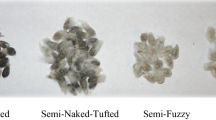Summary
1. Tufted seed (T) is shown to differ in a single gene from fuzzy (t), giving an intermediate heterozygote.
2. The identity of the gene for tufted with that for semi-tufted is established.
3. The modifying factors responsible for the difference between tufted and semi-tufted cause the heterozygote to be almost or completely indistinguishable from fuzzy, and are the same as those responsible for the difference between thick and thin fuzz on fuzzy seeds. One of these modifiers is located in the brown lint—leaf shape linkage group.
4. Fuzz modifiers, but not the main tuft factor, affect slightly the hairiness of the plant body.
5. A long lint factor and a seed weight multiple allelomorph series are located in the same chromosome as the tufted factor. There were no other association between lint characters and fuzz characters.
6. The tufted factor and the lintless factor are independent.
7. Tufted associated freely with: leaf shape, anthocyanin pigment, corolla colour, lint colour (3 factors), leaf nectaries.
8. No satisfactory evidence of linkage was obtained between the lintless factor and leaf shape, anthocyanin pigment, corolla colour, leaf nectaries.
Similar content being viewed by others
References
Afzal, M. andHutchinson, J. B. (1934). “The inheritance of ‘lintless’ in Asiatic cottons.”Indian J. agric. Sci. 3, 1124.
Fisher, R. A. (1934).Statistical Methods for Research Workers. 5th Edition. Oliver and Boyd.
Gammie, G. A. (1907). “The Indian Cottons.”Mem. Dep. Agric. Ind. Bot. Ser,2, No. 2.
Harland, S. C. (1932). “The genetics ofGossypium.”Bibliogr. genet. 9.
Hutchinson, J. B. (1931). “The genetics of cotton. Part IV. The inheritance of corolla colour and petal size in Asiatic cottons.”J. Genet. 24, 325.
—— (1932). “The genetics of cotton. Part VIII. The inheritance of anthocyanin pigmentation in Asiatic cottons.” Ibid.26, 317.
—— (1934). “The genetics of cotton. Part X. The inheritance of leaf shape in AsiaticGossypiums.” Ibid.28, 437.
Kottur, G. L. (1927).Nature, Lond.,119, 747.
Leake, H. M. (1914). “Studies in Indian Cottons. Part I.”Mem. Dep. Agric. Ind. Bot. Ser.6, No. 4.
Yates, F. (1934). “Contingency tables involving small numbers and the χ2 test.”J. Roy. Statist. Soc. Suppl.1, 217.
Author information
Authors and Affiliations
Rights and permissions
About this article
Cite this article
Hutchinson, J.B. The genetics of cotton. Journ. of Genetics 31, 451–470 (1935). https://doi.org/10.1007/BF02982411
Issue Date:
DOI: https://doi.org/10.1007/BF02982411




